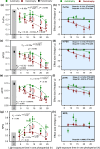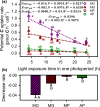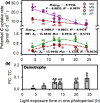Prolonged light exposure time enhances the photosynthetic investment in osmotrophic Ochromonas
- PMID: 40552826
- PMCID: PMC12285262
- DOI: 10.1128/aem.01032-25
Prolonged light exposure time enhances the photosynthetic investment in osmotrophic Ochromonas
Abstract
The photoperiod, as a critical external environmental signal, triggers a cascade of signaling responses in organisms that significantly affect photosynthetic efficiency and photomorphogenesis in autotrophs, while also influencing behavioral patterns and activity rhythms of heterotrophs. Despite its importance, the mechanisms by which mixotrophs respond to photoperiod changes remain largely unexplored. It is crucial for understanding metabolic plasticity how mixotrophs respond to light availability and make optimal decisions during diurnal transitions by regulating their autotrophic and osmotrophic pathways. Therefore, this study focused on Ochromonas gloeopara, a eukaryotic protist capable of both photoautotrophic and osmotrophic growth, aiming to explore the metabolic strategies of mixotrophs in response to changes in photoperiod. The results showed the following. (i) Under autotrophic conditions, the optimal photoperiod for photosynthetic efficiency in Ochromonas was approximately 12 h of light exposure, while prolonged light exposure beyond this duration reduced photosynthetic investment and efficiency, accompanied by an increase in heat dissipation to prevent photodamage. (ii) Under osmotrophic conditions, O. gloeopara adapted to prolonged light exposure by reducing. The reliance on external organic carbon sources and enhancing photosynthetic capacity, thereby shifting towards a more autotrophic metabolic mode. This study systematically elucidates the nutritional strategies of mixotrophic O. gloeopara in response to photoperiod changes at the levels of population dynamics, photosynthetic physiology, and carbon acquisition pathways, deepening our understanding of the response to photoperiodic changes in mixotrophs. These findings provide important theoretical insights for understanding the functional roles of mixotrophs in ecosystems and for accurately predicting changes in global carbon cycles.
Importance: Mixotrophs possess flexible metabolism modes and multiple ecological roles, making them sensitive to environmental changes. Due to their widespread distribution and unique nutritional strategy, they serve as key functional groups in marine and freshwater ecosystems, with significant roles in global biogeochemical cycles. Photoperiod, a critical environmental cue, regulates circadian rhythms and may influence the metabolic strategies of mixotrophs. Therefore, this study focused on how the mixotrophic microorganisms Ochromonas gloeopara adjusted autotrophic and osmotrophic pathways in response to photoperiodic changes. These findings highlight the metabolic flexibility of mixotrophic organisms in response to photoperiodic changes, providing new insight on how mixotrophs regulate the flow of materials and reshape the food web structures. This research offers valuable and innovative perspectives for understanding the functional roles of mixotrophic microorganisms in ecosystems, with important implications for improving the accuracy of global carbon cycle predictions.
Keywords: carbon acquisition; metabolic plasticity; osmotrophy; photoperiod; photosynthesis.
Conflict of interest statement
The authors declare no conflict of interest.
Figures







Similar articles
-
Management of urinary stones by experts in stone disease (ESD 2025).Arch Ital Urol Androl. 2025 Jun 30;97(2):14085. doi: 10.4081/aiua.2025.14085. Epub 2025 Jun 30. Arch Ital Urol Androl. 2025. PMID: 40583613 Review.
-
Adapting Safety Plans for Autistic Adults with Involvement from the Autism Community.Autism Adulthood. 2025 May 28;7(3):293-302. doi: 10.1089/aut.2023.0124. eCollection 2025 Jun. Autism Adulthood. 2025. PMID: 40539213
-
The Black Book of Psychotropic Dosing and Monitoring.Psychopharmacol Bull. 2024 Jul 8;54(3):8-59. Psychopharmacol Bull. 2024. PMID: 38993656 Free PMC article. Review.
-
Systemic Inflammatory Response Syndrome.2025 Jun 20. In: StatPearls [Internet]. Treasure Island (FL): StatPearls Publishing; 2025 Jan–. 2025 Jun 20. In: StatPearls [Internet]. Treasure Island (FL): StatPearls Publishing; 2025 Jan–. PMID: 31613449 Free Books & Documents.
-
Short-Term Memory Impairment.2024 Jun 8. In: StatPearls [Internet]. Treasure Island (FL): StatPearls Publishing; 2025 Jan–. 2024 Jun 8. In: StatPearls [Internet]. Treasure Island (FL): StatPearls Publishing; 2025 Jan–. PMID: 31424720 Free Books & Documents.
References
-
- Forsythe WC, Rykiel EJ Jr, Stahl RS, Wu H, Schoolfield RM. 1995. A model comparison for daylength as a function of latitude and day of year. Ecol Modell 80:87–95. doi: 10.1016/0304-3800(94)00034-F - DOI
-
- Solovchenko AE, Tkachyov EN, Tsukanova EM, Shuryhin BM, Khruschev SS, Konyukhov IV, Ptushenko VV. 2022. Winter dormancy of woody plants and its noninvasive monitoring. Moscow Univ BiolSci Bull 77:41–53. doi: 10.3103/S0096392522020110 - DOI
MeSH terms
Grants and funding
LinkOut - more resources
Full Text Sources

